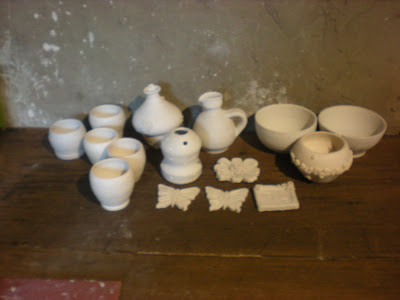 CRAP!! All of the pieces had some sort of defect that cannot be solved. I did some research on the web and some of the books we have and this is what went wrong.
CRAP!! All of the pieces had some sort of defect that cannot be solved. I did some research on the web and some of the books we have and this is what went wrong.Crazing
Crazing is the most common defect, and normally the easiest to correct. In both crazing and shivering the eradication of problems relies on matching the thermal expansion characteristics of both body and glaze. In practice, the most effective ways to correct crazing are:
1. increase the silica, in body or glaze
2. decrease the feldspar, in body or glaze
3. decrease any other material containing sodium or potassium
4. increase the boron
5. increase the alumina, i.e. the clay content
6. increase lead oxide.
Shivering
Shivering is the most problematic of glaze defects, particularly in any functional ware, since slivers of glaze from the edges can drop into food or drink. These slivers are usually small, sharp, jagged-edged pieces that detach themselves from the body. It is the most dangerous of glaze faults. Shivering is the reverse of crazing, therefore the remedies are the opposite as well:
1. decrease the silica in either the body or the glaze
2. increase the feldspar, especially sodium feldspar or nepheline syenite, or other alkaline bearing materials.
 Blisters
Blisters Blisters and blebs are usually the result of either an excessively thick application of glaze or incomplete clay preparation, wedging, blunging, etc. Sometimes, however, these faults can be due to overfiring or to the use of soluble fluxes in the glazes. The following fluxes might cause this problem: borax, boric acid, potassium carbonate, magnesium sulfate, and sodium carbonate. If these materials are present in a problem glaze, it would be well to replace them with other fluxing agents, or fritted materials.
 Pitting and Pinholing
Pitting and Pinholing These are the most annoying and difficult glaze flaws to cure. They can be caused by a badly controlled firing cycle, the glaze composition, or can originate with the body, particularly highly grogged clay bodies. The following remedies should be tried to cure pinholing or pitting:
1. lengthen the firing cycle
2. apply the glaze less thickly
3. add more flux to the glaze to make it more fluid
4. decrease the content of zinc or rutile in the glaze
5. where zinc is used, try calcining half or all of the zinc content
6. increase the maturing temperature of the glaze
7. hold the kiln at the glaze maturing temperature for a soaking period of up to two hours
8. cool the kiln slowly.
This post was excerpted from by Robin Hopper’s popular book The Ceramic Spectrum
Here's where I found the info: http://ceramicartsdaily.org/
So basically I think we coated the pieces to thickly and since its only the first glaze firing we do no we know more or less how long and how hot we want the kiln.
This last glaze I liked. It was applied with a brush as opposed to dipping like the others. I will post the recipe for this glaze after we test it a few more times.

There was some shivering but I think it was mostly cuz we opened the kiln too soon.
 We'll be doing test tiles next time, instead of test "mates".
We'll be doing test tiles next time, instead of test "mates".









No comments:
Post a Comment